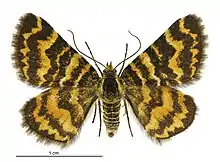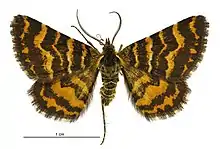Notoreas perornata
Notoreas perornata is a species of moth in the family Geometridae. It is endemic to New Zealand.
| Notoreas perornata | |
|---|---|
 | |
| Female | |
 | |
| Male | |
| Scientific classification | |
| Kingdom: | Animalia |
| Phylum: | Arthropoda |
| Class: | Insecta |
| Order: | Lepidoptera |
| Family: | Geometridae |
| Genus: | Notoreas |
| Species: | N. perornata |
| Binomial name | |
| Notoreas perornata | |
| Synonyms[2] | |
| |
Taxonomy
This species was first described in 1863 by Francis Walker using material collected in either Hawkes Bay or Taupo by William Colenso and named Fidonia perornata.[1][3][2] In 1884 Meyrick placed this species within the genus Pasithea.[4] In 1886 Meyrick renamed the genus to which he had previously assigned this species and placed it within the genus Notoreas.[5] George Hudson discussed and illustrated this species both in his 1898 book New Zealand Moths and Butterflies (Macro-lepidoptera) using the name Notoreas perornata and again in his 1928 book The Butterflies and Moths of New Zealand.[6][7] In the later case Hudson followed Louis Beethoven Prout and used the name Lythria perornata.[8][2] John S. Dugdale regarded the 1898 illustrations as not a good match but approved of the illustration done by Hudson in 1928.[2] The genus Notoreas was reviewed in 1986 by R. C. Craw and the placement of this species within it was confirmed.[9]
In 2010 Brian Patrick, Robert Hoare and Birgit Rhode studied this species and others in its complex and discussed the taxonomy of the species.[10] However species within the genus Notoreas are currently regarded as being in need of revision and in particular this species is regarded as needing more taxonomic work.[11][10] The holotype specimen is held at the Natural History Museum, London.[2]
Description
Walker originally described the species as follows:
Male. Black, pilose, whitish cinereous beneath. Frontal tuft prominent. Palpi lanceolate, very pilose, as long as the breadth of the head; third joint conical, minute. Antennae moderately pectinated. Thorax with a white streak on each of the tegulae. Abdomen with luteous speckles; hind borders of the segments white. Fore wings hardly acute, with a slight cupreous tinge and with five luteous partly whitish bands; firsthand straight; second, third and fourth undulating; fifth macular; under side luteous, with five cupreous-black bands. Hind wings luteous, with three undulating cupreous-black bands; exterior border cupreous-black; under side partly white, with the lines accompanied by cupreous-black speckles. Length of the body 1 1⁄3 lines; of the wings 10 lines.[3]
Distribution
N. perornata is endemic to New Zealand.[1][12] This species is found in the North Island from Northland to Westland and in the South Island on the coast in Marlborough.[10]
Life cycle and behaviour
The female moth lays her eggs within the flower buds of their host plant.[13] When the larvae emerge from their eggs, they eat into the leaves or buds of their host, hiding from predators.[13] Once they are large enough, they emerge to feed from the fresh growth of the plant.[13] N. perornata pupate in a loose cocoon on the ground under their host.[13] N. perornata has two generations each year with adults on the wing in the months of October to November and March to April.[10] However, in the northern parts of New Zealand this species may be multivoltine.[10] N. perornata are day-flying moths.[13] They are low but fast flyers and constantly vibrate their wings to enable them to take off rapidly.[13]
References
| Wikimedia Commons has media related to Notoreas perornata. |
- "Notoreas perornata (Walker, 1863)". www.nzor.org.nz. Manaaki Whenua - Landcare Research. Retrieved 13 December 2018.
- Dugdale, John S. (23 September 1988). Lepidoptera - annotated catalogue, and keys to family-group taxa (PDF). Fauna of New Zealand. 14. pp. 1–264. ISBN 978-0-477-02518-8 – via Manaaki Whenua - Landcare Research.
- Walker, Francis (1863). "Geometrites (continued)". List of the Specimens of Lepidopterous Insects in the Collection of the British Museum. 26: 1479–1796 – via Biodiversity Heritage Library.
- Meyrick, E. (May 1884). "A Monograph of the New Zealand Geometrina". Transactions and Proceedings of the New Zealand Institute. 16: 49–113 – via Biodiversity Heritage Library.
- Meyrick, E. (1886). "Notes on Nomenclature of New Zealand". Transactions and Proceedings of the New Zealand Institute. 18: 184 – via Biodiversity Heritage Library.
- Hudson, G. V. (1898). New Zealand Moths and Butterflies (Macro-lepidoptera). London: West, Newman & co. p. 72. doi:10.5962/bhl.title.32466. OCLC 727236768. Retrieved 12 December 2018.
- Hudson, G. V. (1928). The Butterflies and Moths of New Zealand. Wellington: Ferguson & Osborn Ltd. pp. 124–125. OCLC 25449322.
- Prout, Louis Beethoven (1927). "Notes on New Zealand Geometridae". Transactions and Proceedings of the New Zealand Institute. 58: 75–79.
- Craw, R. C. (5 January 2012). "Review of the genus Notoreas (sensu auctorum) (Lepidoptera: Geometridae: Larentiinae)". New Zealand Journal of Zoology. 13 (1): 131–140. doi:10.1080/03014223.1986.10422654.
- Patrick, Brian; Hoare, Robert; Rhode, Birgit (22 December 2010). "Taxonomy and conservation of allopatric moth populations: a revisionary study of the Notoreas perornata Walker complex (Lepidoptera: Geometridae: Larentiinae), with special reference to southern New Zealand". New Zealand Journal of Zoology. 37 (4): 257–283. doi:10.1080/03014223.2010.511127.
- Hoare, R. J. B.; Rhode, B. E.; Emmerson, A. W. (2011). "Larger moths of New Zealand: Image gallery and online guide". Manaaki Whenua Landcare Research. Retrieved 13 December 2018.
- Gordon, Dennis P., ed. (2010). New Zealand Inventory of Biodiversity. Volume Two. Kingdom Animalia: Chaetognatha, Ecdysozoa, Ichnofossils. Vol. 2. Christchurch, N.Z.: Canterbury University Press. p. 460. ISBN 9781877257933. OCLC 973607714.
- Patrick, Brian (Autumn 2015). "Discovering New Zealand's gorgeous moths" (PDF). Butterflies and Moths of New Zealand. New Zealand: Butterflies and Moths of New Zealand Trust. p. 13. Retrieved 12 December 2018.